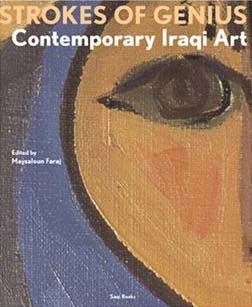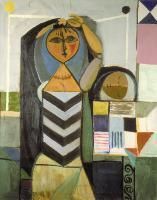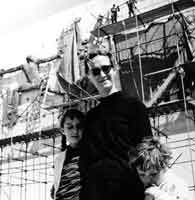

Strokes of Genius: Contemporary Iraqi Art
Published by Saqi Books (2001)
Edited by Maysaloun Faraj
Designed by Sadik Alfraji
Cover Image: detail from Jewad Selim's Two Women
ISBN 0-86356-563-8
For the children of Iraq
'I salute your banks from a distance, so salute me; O Dijla of Prosperity, O mother of gardens'. Mohammed Mahdi al-Jawahiri
Strokes of Genius conveys so well the continuity of Iraqi art throughout the ages. Sir Wilfred Thesiger
A timely reminder of the culture and humanity of the Iraqi people. John Pilger
Art always outlives adversity as it outlives prosperity. This is the lesson
that history has taught us since man first began to decorate the walls of
his cave dwellings. Hence, Strokes of Genius forms an additional proof of
art's permanence despite hardship. Dr Wijdan Ali
An encyclopaedic undertaking inspired by Faraj's national pride and love
for the arts. Iraqi artists, heirs to the creative genius of Mesopotamian
cultures have continued to inspire and empower us through their art. The
consequences of a devastating war followed by an economic embargo are a threat to daily life and to Iraq's future cultural patrimony. Strokes of
Genius is a unique endeavour to safeguard and record the rich and vibrant
contemporary art by Iraqis living at home or in the Diaspora; this
publication and the coinciding exhibitions will fill an important gap in the
field of modern and Arab contemporary art. Salwa Mikdadi Nashashibi
Strokes of Genius is admirable in its concept and splendid in its
presentation and also the dedication of all those working towards its
realisation. Alistair Duncan

Throughout history, Mesopotamia has been referred to as the 'Cradle of Civilisation' and its art, treasured in museums worldwide is praised as one of the greatest achievements of mankind. Today, Iraqi art forms an important facet of the kaleidoscope of global contemporary art to which the artists contribute with a diverse yet distinct vocabulary formed by their unique artistic, cultural and religious roots. Due to recent world events, as a result of which many Iraqis have had to seek alternative existences outside their homeland, an innovative body of artworks by Iraqi artists has emerged and taken shape. Many of these address contemporary themes informed by the complexities of the artists' lives, be it outside Iraq, in the distressed position of being an 'other', or indeed within Iraq, where day to day survival has become for many an enormous
struggle and an unprecedented burden. A culmination of a colossal
five-year effort, this historical undertaking intends to bring together
Iraq's scattered 'talents in the wind' and communicate the positive and
creative energies of Iraqi artists dispersed throughout the world today. Strokes of Genius is meant to serve as a valuable source of reference for those seeking current information about contemporary Iraqi art. Based on extensive research and many personal interviews, this work introduces the reader to the development of Iraqi art throughout recent decades, before moving on to essays by experts in the field who explore the status and content of works produced by Iraqi artists today. Furthermore, it incorporates a comprehensive selection of biographical notes on Iraqi artists, past and present, worldwide. With 40 colour and 170 black and white illustrations.

 Preface Preface
Maysaloun Faraj
The works of Iraqi artists, particularly those of the late 1960s and 1970s, inspired and intrigued me throughout my artistic career. Although I was born and brought up in the USA, where both my parents were studying and working, my growing-up years were essentially in Iraq. There, I graduated from Baghdad High School in 1973, achieved a BSc Architecture from the College of Architectural Engineering, Baghdad University in 1978 and went on to pursue a career in the arts thereafter. It was during that time that I was introduced to prominent artists like Salih al-Jumai'e, Rafa al-Nasiri, Tariq Ibrahim, Dia Azzawi, Mohammed Ghani Hikmet, Hashim al-Samarchi and others...
 An Historical Overview 1900s-1990s An Historical Overview 1900s-1990s
Ulrike al-Khamis
It was early in the 20th century that Iraq received its first impulse for a contemporary art movement in the Western sense. At that time still part of the Ottoman empire, artistic activity had long been stagnant in the land between the two rivers. Indeed, ever since the devastating Mongol invasions in the 13th century and in particular the annihilation of Baghdad in 1258, the arts and crafts of the country, deprived of their material roots and bereft of direct high-level patronage, appear to have descended into qualitative and quantitative obscurity. Traditional Arab calligraphy was one of the few art forms that continued to be of high quality. In the 20th century this genre had a celebrated exponent in the outstanding Hashim Mohammed al-Baghdadi, better known as Hashim al-Khattat. Today, Hashim's only student, Ghani al-Ani, continues the master's legacy from his base in Paris...
 Lorna Selim Remembers Lorna Selim Remembers
With Ulrike al-Khamis
When I first met Jewad at the Slade School of Art in London in 1946, it was music rather than art that drew us together. He was passionate about the classical guitar and I was a very amateur violinist. Our studies, meanwhile, went along at different levels. Jewad, the son of one of the pioneer artists in Iraq, and member of a vibrant artistic family, had come on a scholarship to study sculpture. He had already studied in Paris and Rome and at twenty-six knew exactly what he wanted from his stay in London and had strong ideas about how he wanted to work. Originally, he had been sent to the Chelsea School of Art, but he disliked the tight regime there and persuaded the Iraqi embassy to find him a more inspiring institution, which turned out to be the Slade School. I was seventeen and came to the Slade straight from school, also with a scholarship, to study painting and design. Our courses ran along conventional academic lines - drawing in the Antiques room, then life drawing, followed by oil painting or modelling also from life...
 Consciousness of Isolation Consciousness of Isolation
Hana Mal Allah
In June 1991, the Department of Plastic Arts in Iraq invited ten young painters to exhibit their work at the Arts Centre in Baghdad. As the majority of participants were under thirty-five years of age at the time, the art critics referred to them as the eighties generation. These artists were deeply committed to their work and to the development of their art through experimentation. They had already held various solo and group exhibitions. However, this invitation led to a new public recognition of their work, which was further legitimised and consolidated by constructive criticism from the art establishment. Indeed, the exhibition provided an opportunity for the first time to examine, compare and verify the credibility of the achievements of the eighties generation. For the general public, furthermore, the show served as an aesthetic introduction to the state of modern Iraqi art at that time...
 Diaspora, Departure and Remains Diaspora, Departure and Remains
Rashad Selim
The survival and continuity of a creative and expressive spirit that is peculiarly Iraqi despite or even due to overwhelming odds - over and over again - marks our character and defines much of our art. This can be said about Mesopotamian art from any epoch and is not confined to fine art there having survived a tradition of folk art throughout that to this day is a prime inspirational lodestone. This spirit was never a product of isolation but more one of beginnings and ends, of destination and point of departure, of peoples drawn into the Mesopotamian heart at the geographic crossroad of history, of synthesis and influence. Richly endowed, the land is one of clear-cut intensity in the contrasts of light and shade, mountain and plain, flood and drought, creation and loss, promise and betrayal. What is special today is the scope of the betrayal that has befallen the promise of an age with all its knowledge and potentials and the magnitude of waste and dispersion influencing every aspect and strata of the land and people. The Iraqi diaspora is not a sudden exodus but one that has grown exponentially through the 20th century as each generation faced some form of radical transition or intense conflict. This has resulted in the accumulation over time of fragments representing every segment of Iraqi society and political or religious persuasion in exile. The generalization of this estrangement has within recent years taken on the land itself. Iraq has been...
 Game of Burning Stones: Between Establishment and Change Game of Burning Stones: Between Establishment and Change
Ibrahim Rashid
One day when I was talking with my wife, the sculptress Maha Mustafa, she suddenly recalled an incident from her childhood when she was ten. She was visiting the city of Kirkuk in northern Iraq with her parents. There she used to play with her friends throwing rocky stones on the ground while they danced. The soil being rocky and rich in oil set the stones alight creating some magical coloured flames on the naked black eartha game of nature and childhood I called it the Game of Burning Stones...

Maysaloun Faraj, London, England
Born USA, 1955 to Iraqi parents. BSc Architecture, Baghdad University,
Iraq, 1978. Faraj has contributed to more than forty group exhibitions at
local and international level, won numerous awards and has held fourteen
one-woman shows to date. Her artworks are in private collections world wide as well as important public collections including the British Museum; the National Museum for Women in the Arts, Washington; The Wereldmuseum, Rotterdam and national institutions throughout the Middle East. Recent group participation includes the touring exhibitions: Dialogue of the Present, UK, 1999/2000; Artists for Human Rights, South Africa, 1999; Forces of Change, USA 1994-5; Arabian Eyes, Department of Culture and Information, United Arab Emirates, 1995. Faraj has lived and worked in the UK since 1982.
Ulrike al-Khamis, Edinburgh, Scotland
Formerly Curator of Muslim Art and Culture at Glasgow Museums. In 1999
Al-Khamis joined the National Museums of Scotland where she is currently
Curator of South Asia and the Middle East. Her most recent achievement was the staging of Scotland's first ever large-scale festival of Moslem Art and Culture: SALAAM. This involved exhibitions throughout Glasgow Museums' venues as well as events and workshops organised by the Museums and the Performing Arts Department. Ulrike al-Khamis is Senior Advisor to the Strokes of Genius project and Senior Contributor to this publication.
Hana Mal Allah, Baghdad, Iraq
Born Thee Qar, Iraq, 1958. Mal Allah is a dedicated young Iraqi artist,
writer and researcher who studied under the guidance of the eminent Shakir Hassan Al Said. A member of the International Artists Association (UNESCO) and the League for Iraqi Fine Arts Critics. Her work is in numerous private and public collections including the National Museum of Modern Art in Baghdad and the Institut du Monde Arabe, Paris. A founding member of Hewar, co-editor of Al-Wasiti art journal (published by the Arts Department, Ministry of Education, Baghdad) and is currently the Head of the Graphics Department at the Institute of Fine Arts in Baghdad.
Ibrahim Rashid, Malmö, Sweden
Born Baghdad, Iraq, 1957. Rashid is a prolific artist, researcher and a
writer who builds on his own heritage and is very much interested in nature and the environment and has been involved in important national public commission work sponsored by the Swedish authorities. Rashid is a former student of Shakir Hassan Al Said. His work can be found in numerous private and public collections including the National Museums of Modern Art in Baghdad, Amman and Sweden.
Lorna Selim, Abergavenny, Wales
Born Sheffield, UK, 1928. Lorna was the wife of the late Iraqi artist Jewad
Selim a leading figure in Iraq's modern art movement and a major influence on Arab art in general. She won a scholarship at the Slade School of Fine Arts where she was awarded a Diploma in 1948. Lorna Selim became a member of the Iraqi Artists Society when it was founded in 1956 and participated in all their exhibitions as well as shows in India, Lebanon, UK, Yugoslavia and the USA. In 1966 she won the Gulbenkian Foundation gold medal for painting.
Rashad Selim, England, Europe and Morocco
Born Khartoum, Sudan, 1957 to Iraqi/German parents. Rashad is nephew to the late Jewad Selim and a junior member of the Selim Dynasty of artists. Gained a Diploma in Graphics and Printmaking, Institute of Fine Arts, Baghdad, 1980 and went on to develop his techniques achieving a further degree in audio/visual arts, St Martins School of Art, London, 1983. He is also a traveler, illustrator, designer, educator and a scholar who has contributed to numerous group exhibitions in addition to staging his one-man shows throughout Europe and the Middle East. His work is in numerous private and public collections including the British Museum. Rashad is a profound member of the Strokes of Genius project.
Wijdan Ali, Amman, Jordan
President and Founder of the Royal Society of Fine Arts, and Vice President of the Jordan Institute of Diplomacy, Dr Wijdan Ali is a prominent artist, contributor and editor of Contemporary Art from the Islamic World, 1989 and Modern Islamic Art; Development & Continuity, 1997 and contributing editor to Arts & the Islamic World, and Macmillan's Dictionary of Art.
To order a copy of the book please email info@incia.co.uk.
|
